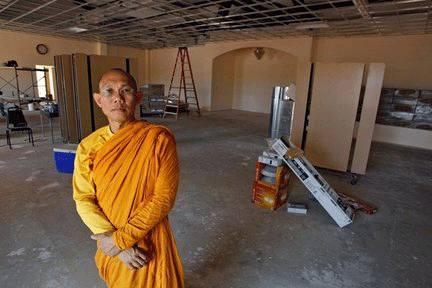
On 5 acres in south Mobile County, a Buddhist temple rises against a backdrop of red clay and pines. Nearly completed, the structure — rectangular, gray, with a large interior space — is still a construction zone, its floors and altar not quite finished.
Outside, a gold Buddha keeps watch, looking off across the fields.
Wat Buddharaksa Temple — a house of worship for the Thai and Laotian Buddhist community — was destroyed by an accidental fire, in March 2008, at its location on Murray Heights Drive in Irvington.
The Buddhists in the area came together, says Visanou Khamphouy, president of the congregation, and raised money to rebuild.
Khamphouy, who arrived in the United States as a refugee from Laos in 1978, is now an established businessman.
He says that the community paid about $65,000 for the acreage off Boe Road, with an investment of about $240,000 for the temple structure.
By mid-May, says a Buddhist monk at the temple, the new site will be ready for worshippers.
“We serve the people for the Buddhist customs, chanting, and meditations,” says the monk, Chaiwat Moleechate, who is known as the Rev. Chaiwat. He is from Thailand and has been in the Mobile area for over a decade.
In addition to experiencing the loss of the temple to fire, the community endured Hurricane Katrina and now faces the threat of the giant oil spill that has already slowed the local economy.
The presence of suffering — and how to deal with suffering — is central to Buddhist philosophy, Chaiwat explains.
“The people work in the seafood factory,” he says of many of the Asians who participate in ceremonies at his temple.
“For the people, there are no jobs. The problem is from the oil in the sea, that’s the problem right now. All the crab boats, and the fishermen, they cannot work.
“That’s why the people down here don’t know how they’re going to survive.
“When the people have no jobs, how is the temple going to stand? The money, the income, is from donations.”
But the monk, philosophical, explains that “the mind” adds to the sense of suffering.
“If you create the sense of suffering in your mind,” he says, “you double the suffering.
On May 15 and 16, the temple will celebrate the New Year according to traditions of the Theraveda Buddhists.
The “Songkran Festival,” as it is known in Thailand, he says, is a “water festival.”
Although it is traditionally celebrated in April, Chaiwat says that the monks of Wat Buddharaksa decided to wait until the building was finished before hosting the festive — and spiritual — event.
Chaiwat says that he is among a group of five monks and one nun who live on the temple grounds.
Dressed in orange robes, barefoot, with shaved head and wearing eyeglasses, Chaiwat is energetic and learned.
He explains that he grew up in “a very poor family” near the Laotian border, and began his religious studies at age 12.
He became a monk at age 21.
He says he knew little English when arriving in America, but “I learned it from TV.”
Shortly before noon on a May morning, he steps across the grounds, greeting temple members who are taking part in helping finish the construction.
He enters a storage area where the Buddha statues have been kept during the long absence of a temple.
The small room is filled with the faces of the Buddha.
He points to a Buddha from Sri Lanka, another from Japan. A large, gold Buddha, in a sitting position, is against the wall.
Once the temple is ready, the Buddhas and other figures — boddhisatvas, who were great teachers in the Buddhist tradition — will be moved to the altar and other locations.
The Buddhas, he says, were not hurt by the fire.
The monk attributes that miracle to “the blessings from the Buddha,” and “all the prayers of the people and the monks.”
He speaks of the Buddha as a model of perfection, a way of life, and thought, to which he aspires.
Meditation and chanting, he explains, are central to the Buddhist practices.
From that meditation, he says, can come calmness.
“We try to lead the Buddhist people to meditate. To cool down, to slow down. The clear mind. The pure mind.
“The people understand how to make them (selves) happy. The pure mind, the clear mind, the pure spirit, too.”
He says the “clear mind” enables a person to accept what happens, and to find new direction.
At noon, Chaiwat goes inside his house and eats one of his two daily meals.
Khamphouy has also come into the house with some family members. They do not disturb Chaiwat while he is eating.
When Chaiwat finishes, he presses his hands together and intones a long, meditative chant.
Khamphouy and the others kneel on the floor and close their eyes. When the monk is finished, they get up and come to the table.
Chaiwat goes and takes a place on the couch, taking a break, while the others enjoy their lunch of Thai food.
| Buddhist temple rebuilds after fire |
Source : http://blog.al.com




